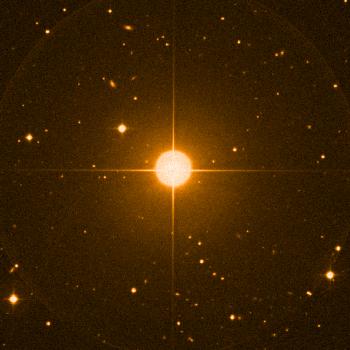Why are brown dwarfs so dim?
- Transfer
Oh, these stars ... Giant fireboxes of nuclear fusion. They (like our Sun) burn hydrogen, turning it into helium (and other elements) and in the process emit a lot of visible light and energy.

But if you look at a brown dwarf, it will not look like a normal star (from the main sequence), like our Sun. Brown dwarfs can not give enough pressure to burn the hydrogen turned into helium. They can only convert hydrogen to deuterium.
Let's look at the differences in these processes. The nucleus of a hydrogen atom is just a proton, with a mass of 938.272 MeV / c 2 (I use these units, because they are very easy to convert into energy, simply multiply by c 2 , since E = mc 2). The deuteron, the nucleus of deuterium, contains a proton and a neutron (with a mass of 939.566 MeV / c 2 ), but since they are connected in place, the total mass of the deuteron is slightly less than the mass of two protons, 1875.613 MeV / c 2 . Therefore, when two protons merge, as a result of which a deuteron appears, an energy of 0.931 MeV is released. Wait a second - this is not quite so ... They also need to save quantum numbers, such as charges and lepton numbers. So they need to produce a positron and a neutrino: but do not worry, the positron will annihilate in a star with an electron and add extra 0.511 MeV of energy to you, and raise the total amount to 1.442 MeV by one synthesis reaction.

In most stars, this is the first step in a chain reaction leading to the production of helium-4, having a total mass of 3,727.38 MeV / c 2 . This means that for every 4 protons that synthesized helium-4, we get (including two resulting positrons, annihilating with electrons and releasing additional energy), 26.73 MeV of energy. And this is how helium-4 is obtained from deuterium and protons:

As a result, having spent the same amount of mass (say, 4 protons) for energy production, brown dwarfs give out only 11% of the energy of an ordinary star. If we add to this their low mass, reduced synthesis rate, we will answer the question of why brown dwarfs are so dull. So how dull are they? Perhaps this illustration will help you imagine:

Next time, going outside, thank the friendly nearby Sun for warmth, brightness and mass. Otherwise, our world would be a cold and lonely place.

But if you look at a brown dwarf, it will not look like a normal star (from the main sequence), like our Sun. Brown dwarfs can not give enough pressure to burn the hydrogen turned into helium. They can only convert hydrogen to deuterium.
Let's look at the differences in these processes. The nucleus of a hydrogen atom is just a proton, with a mass of 938.272 MeV / c 2 (I use these units, because they are very easy to convert into energy, simply multiply by c 2 , since E = mc 2). The deuteron, the nucleus of deuterium, contains a proton and a neutron (with a mass of 939.566 MeV / c 2 ), but since they are connected in place, the total mass of the deuteron is slightly less than the mass of two protons, 1875.613 MeV / c 2 . Therefore, when two protons merge, as a result of which a deuteron appears, an energy of 0.931 MeV is released. Wait a second - this is not quite so ... They also need to save quantum numbers, such as charges and lepton numbers. So they need to produce a positron and a neutrino: but do not worry, the positron will annihilate in a star with an electron and add extra 0.511 MeV of energy to you, and raise the total amount to 1.442 MeV by one synthesis reaction.

In most stars, this is the first step in a chain reaction leading to the production of helium-4, having a total mass of 3,727.38 MeV / c 2 . This means that for every 4 protons that synthesized helium-4, we get (including two resulting positrons, annihilating with electrons and releasing additional energy), 26.73 MeV of energy. And this is how helium-4 is obtained from deuterium and protons:

As a result, having spent the same amount of mass (say, 4 protons) for energy production, brown dwarfs give out only 11% of the energy of an ordinary star. If we add to this their low mass, reduced synthesis rate, we will answer the question of why brown dwarfs are so dull. So how dull are they? Perhaps this illustration will help you imagine:

Next time, going outside, thank the friendly nearby Sun for warmth, brightness and mass. Otherwise, our world would be a cold and lonely place.
